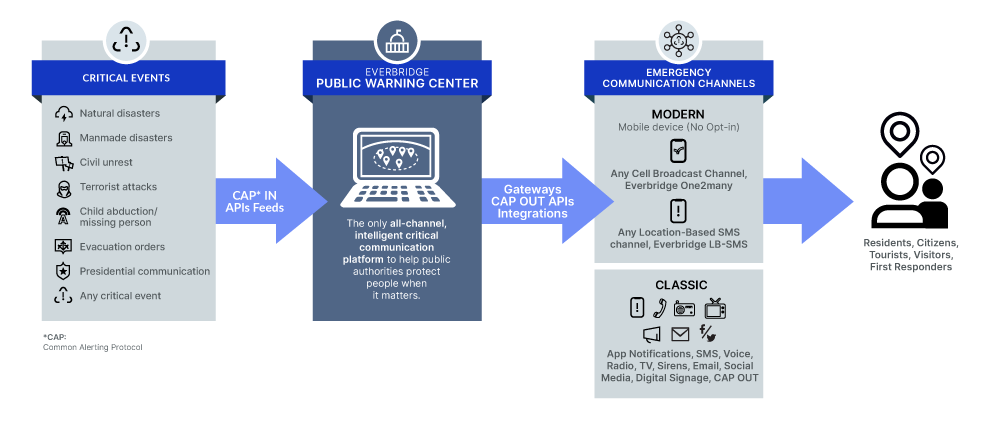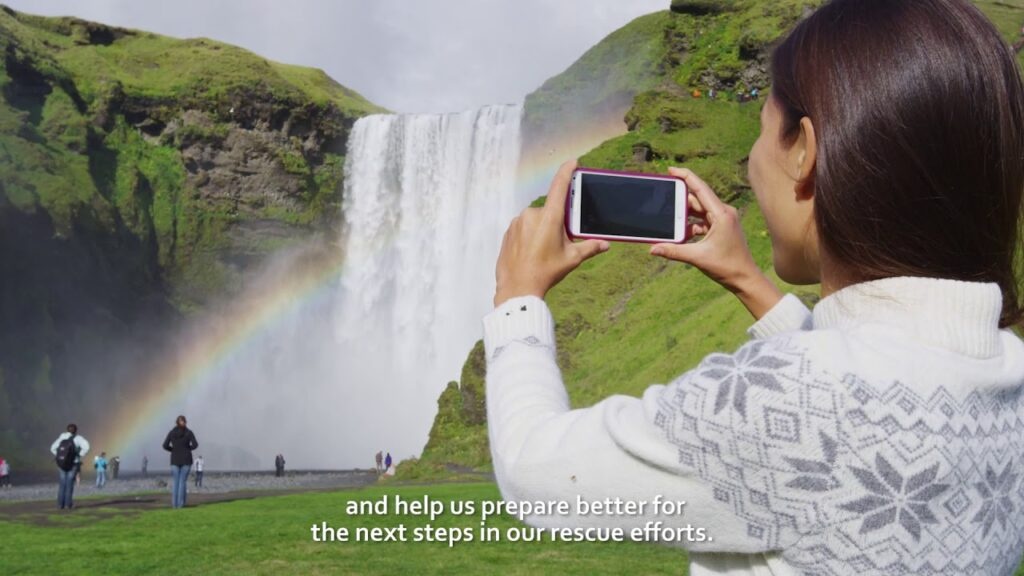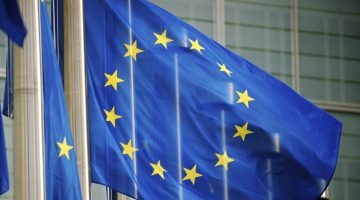EECC Article 110
European public warning systems

A blueprint for mandatory nationwide population alerting
When critical events happen it is the duty of governments and first responders to warn and inform everyone at risk. Public warning systems are an effective way to provide citizens and visitors from other countries with trusted information to help them stay safe.
By June 2022, the European Electronic Communications Code (EECC) Article 110 requires all EU countries to operate a public warning system that can send geo-targeted emergency alerts to all mobile phone users located in the affected area during a natural or man-made disaster.
In 2020, BEREC (the Body of European Regulators for Electronic Communications) published their guidelines on how to assess the effectiveness of public warning systems transmitted by different means, to help governments implement Article 110.
Why Everbridge?
The Everbridge public warning platform meets and exceeds the requirements of EECC Article 110
Everbridge is the only vendor that can deliver both the technologies recommended by BEREC, in a single platform and without the need for any third party dependency. Everbridge is the world’s most trusted national public warning solution. Our purpose-built platform offers unique benefits:
- Meets and exceeds the requirements of EECC Article 110
- Modular, flexible, expandable
- Integrates with multiple channels including:
- Our own Best in class cell broadcast technology
- Our own best in class location-based SMS technology
- Engineered, built and supported in Europe
Everbridge provides national warning systems in ten major European countries and our solutions are used in over 500 governments, states and municipalities around the world.

A trusted public warning system across Europe
Everbridge has deployed solutions for countrywide public warning systems in ten European countries: Iceland, Norway, Sweden, The Netherlands, Greece, Spain, United Kingdom, Estonia, Norway, Denmark.
Flexible public warning deployment options
European countries are not all the same. Population size, the type of critical events and available resources will vary, so a national public warning system must be flexible to meet the needs of the country, now and into the future. The Everbridge public warning platform can be deployed to meet Article 110 according to the needs of the country with scope to add more capabilities in the future.
Everbridge Public Warning Center
A unified, flexible and modular front end, used by approved government agencies to compose and distribute alerts to any combination of chosen channels.
Combination of alerting channels
- Everbridge one2many cell broadcast
- Everbridge location-based SMS
- Secondary channels including: Mobile push notifications • SMS • Voice • Email • CAP compliant for cirens, TVs, Radio, Electronic display boards • Social media – Facebook and Twitter • TETRA

| Incident Lifecycle | Capabilities | *EECC/BEREC Requirements |
Everbridge |
|---|---|---|---|
| Enable geographical targeting | ✔ | ✔ | |
| Provide a scalable alerting solution | ✔ | ✔ | |
| Ability to warn end-users including visitors and inbound roamers | ✔ | ✔ | |
| Supported devices, all mobile devices from mobile phone to smartphone | ✔ | ✔ | |
| No human interaction needed for recipient to enable receiving warning messages | ✔ | ✔ | |
| Ability to send messages in different languages | ✔ | ✔ | |
| Ability to manage longer messages | ✔ | ✔ | |
| Enable accessibility to end-users with disabilities | ✔ | ✔ | |
| Provide a reliable PW system | ✔ | ✔ | |
| Ability to alert end-users entering the area after the initial warning | ✔ | ✔ | |
| Provide situational Awareness to understand population density and movements | – | ✔ | |
| Ability to reach end-user that have been in the affected area before the initial warning | – | ✔ | |
| Ability to combine all mobile communication technologies into one PW system | – | ✔ | |
| Ability to assess population density and crowd movement | – | ✔ | |
| Alert citizens and visitors before, during and after critical events | – | ✔ | |
| Ability to declare lockdowns, re-openings and pandemic spread | – | ✔ | |
| Ability to communicate with your citizens abroad | – | ✔ | |
| Ability to assess post-evacuation situation – Leave no-one behind | – | ✔ | |
| Provide a modular and flexible system to accommodate any PWS setup | – | ✔ | |
| Provide a modern PW system | – | ✔ | |
| Ability to communicate with end-users through all the incident lifecycle | – | ✔ | |
| Ability to transmit alerts with a specific tone | – | ✔ | |
| Ability to identify end-users left behind in affected areas | – | ✔ | |
| Ability to reach end-users that have been in the affected area before the initial warning | – | ✔ | |
| Ability to send targeted alerts based on end-user’s nationality, special needs | – | ✔ | |
| Ability to send alerts without accessing any PII data from the network | – | ✔ | |
| Ability to define an incident zone for automatic alerting on entering | – | ✔ | |
| Ability to alert end-users via multiple channels Location-Based SMS • Cell Broadcast • Mobile Push Notification • SMS • Voice • Email • CAP Compliant for Sirens • TVs • Radio • Electronic Display Boards • Social Media – Facebook and Twitter • TETRA | – | ✔ | |
| Compliance: EECC Article 110, BEREC, EU-Alert, WPAS, KPAS, ETWS, EMA, CMAS, WEA. | – | ✔ |
“Knowing exactly how many people there are in the area can help us better understand the gravity of a situation and help us better prepare for the next steps in our rescue efforts. The good thing about location-based alerting systems is that you can ‘geofence’ and identify new mobile devices coming into a particular area and you can then tailor messages for newcomers and send them the information they would have received if they’d been in that area earlier.”
Latest news
Related resources

Article 110 of the EECC
By June 2022, all EU member states must meet the requirements of Article 110 of the European Electronic Communications Code (EECC). The code requires countries to implement a public warning system which uses mobile phone technology. Find out more in this guide from EENA.








